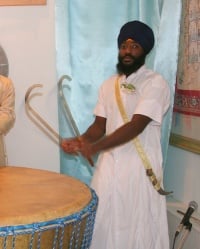Nagara
Nagara or Ranjit Nagara: Literally: the drum (Nagara) of victorious (Ranjit) or the "drum of victory". Nagara is a percussion instrument. Nagaras are huge drums, about 2 to 3 feet in diameter, and played with sticks. The special Ranjit Nagara can be up to 5 feet across. Traditionally, Nagaras used to be a war-drum. Its beat heralded the arrival of kings and princes and meant that the army was marching into battle. Today, they are now played on festive occasions.
In 1684, Guru Gobind Singh got a special drum prepared. It was named Ranjit (the winner of the battle-field). This drum was beaten at Keshgarh Sahib throne, at Anandpur Sahib, every day, as a declaration of the sovereignty of the Khalsa (pure ones). Guru Sahib made it obligatory that before the closing of Gurdwara, Nagara must be beaten. Nagara is a symbol of sovereignty of the truth and righteousness. Only the winner of a battle could beat it. Nishan (flag) and Nagara (drum) are an integral part of a Takht (Khalsa Throne) and all the Gurdwaras.
Nagar has two kettledrums of different sizes. It is often played in pair, known as Joh Nagara. The bigger one is made of copper and is covered with buffalo skin to produce a heavy and deep sound. The smaller one is made of steel and is covered with camel skin, thus producing a light sound.
- Audio Clip of Ranjit Nagara Drum being played with a fast pace.

